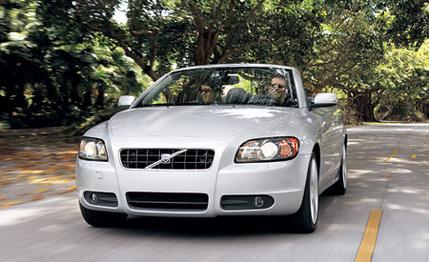 First Drive Review
First Drive Review
The Mercedes SLK really started something in 1996. Its retractable hardtop showed you could have two cars in one-a full convertible and a cozy, secure coupe. Mercedes did the same trick to its larger SL model, and the idea spread among European automakers, particularly to inexpensive four-seaters rather than two-seat sports cars. Suddenly, convertibles were back in fashion, thanks to fliptops.
The premium convertibles-from Audi, BMW, Saab, Volvo-were looking a bit old-fashioned. Now they are catching up with the volume brands. The upcoming BMW 3-series convertible has a retractable hardtop but will be beaten to the market by the Volvo C70, on sale this month. This is a completely different car from the first C70 convertible: It's shorter, lower, and stiffer, but with similarly comfortable four-seat accommodation.
Making these tops is a specialized job but so, too, for Volvo, is making a low-volume model like a coupe or convertible. The C70, like its predecessor, is produced in a Volvo plant that isn't run by Volvo. The Uddevalla plant on the Swedish coast had been run by British consultant TWR, but TWR failed just as demand for that first C70 was fading. Undeterred, Volvo's owner, Ford, did a new deal for the Swedish automaker to build the new C70 at Uddevalla in a joint venture with Italian firm Pininfarina. It helped that, at the time, Pininfarina and sunroof specialist Webasto had a joint-venture company that had been commissioned to design the C70's retractable hardtop.
Although it is Ferrari's preferred design house, Pininfarina had nothing to do with the overall shape of the C70, which was created when design boss Peter Horbury was at Volvo; Horbury, a Brit, is now shaping the future of Fords in North America. Using the mechanical basis of the current S40 and V50 (and thus the European-but not American-Ford Focus), Volvo's own studio first styled the C70 as a coupe and then found a way to accommodate a retractable hardtop. That's why the C70 looks so good. It has a balance of line that many four-seaters with this kind of roof system fail to achieve.
The result is a fiendishly complicated three-section steel roof; only the Volkswagen Eos (see page 56) has more pieces, hinges, and clamps. You really need to use your hands to describe what is involved in raising or lowering the top, which takes 30 seconds, but here goes: The trunklid opens at its leading edge. The front roof section detaches from the windshield rail and cranks up highest of the three sections, but as it lowers, it's sandwiched between the rear window and rear roof panel, forming a neat stack in the trunk. A height clearance of six feet seven inches is necessary to allow this to work, but the whole bewildering operation requires the driver to just keep pressure on a console button for 30 seconds. Notable features are the way the fabric headliner unfurls and is tensioned by wires as the roof moves into place and the L-shaped mesh draft screen that clips over the rear seats when driving with two up front. This wind blocker has zippered openings to allow easy parcel stowage and can be folded in half to fit into the trunk with a full complement of passengers onboard.
An advantage of this multi-section roof is that it reduces the trunk space needed to accommodate it, but it still takes up half the trunk space-the top half. To make it easier to get things into the seven cubic feet remaining for storage, a button on the sill motors the stack of roof panels upward to provide an eight-inch-deep opening. Four adults can travel in the C70 with the top down-but not with their holiday luggage. With the roof up, the divider that demarcates the space needed for the roof can be swung out of the way, and carrying capacity is enlarged to 13 cubic feet, about the same as in a Toyota Corolla.
As you might expect from Volvo, the C70 is chockablock with safety devices, including a new development of side airbags that inflate upward from the door panels and maintain enough rigidity to provide protection in a prolonged accident. Roll-over protection is provided by pop-up hoops behind the rear seats and special windshield pillars and frame made of high-strength steel.
Europeans get two engine choices-a 168-hp, 2.4-liter five-cylinder and the turbocharged T5 2.5-liter developing 218 horses-but we'll only see the turbo in the States. At the preview in Dubai, we drove the T5. Like its sedan and sport-wagon counterparts, the turbo model handles crisply but has a slight tendency to torque-steer. The lowered suspension and the optional 18-inch wheels with 235/40 tires make the ride harder, although this was not an issue on the newly built and perfectly smooth roads crossing the desert of the United Arab Emirates. Over the few potholes we did encounter there was just a suspicion of body shudder. Generally, though, for an open car the C70 feels admirably solid.
Because it is about 500 pounds heavier than the S40, the C70 feels less lively and the higher-geared five-speed automatic has noticeably less performance than the six-speed manual.
Cruising with the top down, the frameless side windows up, and the wind blocker in place is pleasantly turbulence-free and not even unduly disturbing at 100 mph. Curiously, with the roof in place, there is more wind noise from around the windshield than in most comparable fixed-roof coupes. Even so, as an all-around two-in-one car, the Volvo moves ahead of its rivals. But a new 3-series entry might change that.